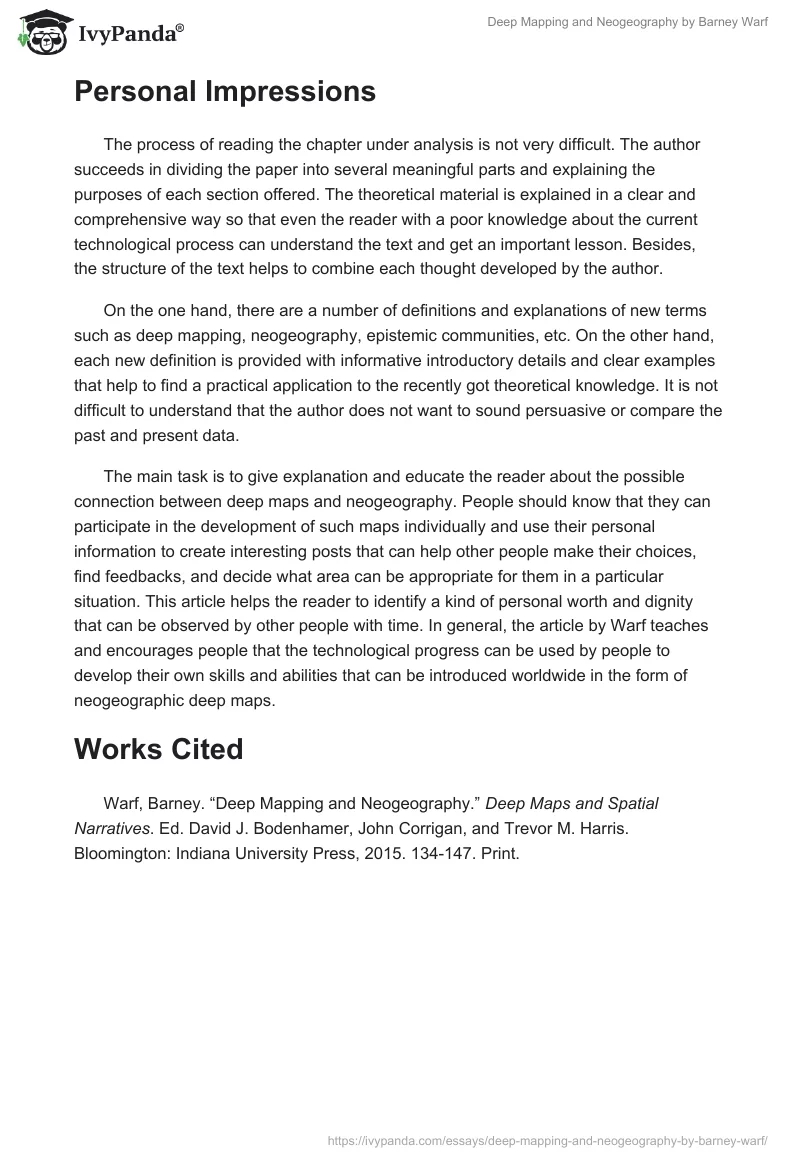Summary
Nowadays, the emergence of technologies promoted a fast development of a number of informative tools, sources, and opportunities for people. Such processes as search for information, choice of jobs, and communication with people distantly have been considerably facilitated. The article “Deep Mapping and Neogeography” written by Barney Warf is about the possible interrelations that can be observed between deep maps and neogeography.
The author divides the paper into several logical chapters where the definitions of such issues as deep mapping and neogeography are given, the essence of neogeographic deep maps is explained, and the example of how such types of maps can be applied in a particular area is offered. A deep map is explained as a “finely detailed depiction of a place, its history, landscape, and culture, and the people, animals, and objects that exist within it” (Warf 135).
Such maps help to introduce an area with a variety of details that can be interesting to many people for different reasons. The author identifies the differences between deep and convention maps explaining that deep mapping is an opportunity to give more qualitative information regarding political, social, and cultural aspects and people’s origins, interests, and purposes. In its turn, neogeography contains epistemological and pragmatic implications that help to construct deep maps. Neogeography is a tool that provides people with an opportunity to document the aspects of a human life and the environment that may influence it.
As a result, neogeographic deep mapping is defined as “an ontological counterpoint for poststructuralist epistemology in that it allows for multiple voices to be heard, leading to a cacophony of representations in which places are depicted and viewed through multiple lenses” (Warf 139).
Personal Impressions
The process of reading the chapter under analysis is not very difficult. The author succeeds in dividing the paper into several meaningful parts and explaining the purposes of each section offered. The theoretical material is explained in a clear and comprehensive way so that even the reader with a poor knowledge about the current technological process can understand the text and get an important lesson. Besides, the structure of the text helps to combine each thought developed by the author.
On the one hand, there are a number of definitions and explanations of new terms such as deep mapping, neogeography, epistemic communities, etc. On the other hand, each new definition is provided with informative introductory details and clear examples that help to find a practical application to the recently got theoretical knowledge. It is not difficult to understand that the author does not want to sound persuasive or compare the past and present data.
The main task is to give explanation and educate the reader about the possible connection between deep maps and neogeography. People should know that they can participate in the development of such maps individually and use their personal information to create interesting posts that can help other people make their choices, find feedbacks, and decide what area can be appropriate for them in a particular situation. This article helps the reader to identify a kind of personal worth and dignity that can be observed by other people with time. In general, the article by Warf teaches and encourages people that the technological progress can be used by people to develop their own skills and abilities that can be introduced worldwide in the form of neogeographic deep maps.
Works Cited
Warf, Barney. “Deep Mapping and Neogeography.” Deep Maps and Spatial Narratives. Ed. David J. Bodenhamer, John Corrigan, and Trevor M. Harris. Bloomington: Indiana University Press, 2015. 134-147. Print.


